Runpeng Yu
Discrete Diffusion in Large Language and Multimodal Models: A Survey
Jun 16, 2025Abstract:In this work, we provide a systematic survey of Discrete Diffusion Language Models (dLLMs) and Discrete Diffusion Multimodal Language Models (dMLLMs). Unlike autoregressive (AR) models, dLLMs and dMLLMs adopt a multi-token, parallel decoding paradigm using full attention and a denoising-based generation strategy. This paradigm naturally enables parallel generation, fine-grained output controllability, and dynamic, response-aware perception. These capabilities are previously difficult to achieve with AR models. Recently, a growing number of industrial-scale proprietary d(M)LLMs, as well as a large number of open-source academic d(M)LLMs, have demonstrated performance comparable to their autoregressive counterparts, while achieving up to 10x acceleration in inference speed. The advancement of discrete diffusion LLMs and MLLMs has been largely driven by progress in two domains. The first is the development of autoregressive LLMs and MLLMs, which has accumulated vast amounts of data, benchmarks, and foundational infrastructure for training and inference. The second contributing domain is the evolution of the mathematical models underlying discrete diffusion. Together, these advancements have catalyzed a surge in dLLMs and dMLLMs research in early 2025. In this work, we present a comprehensive overview of the research in the dLLM and dMLLM domains. We trace the historical development of dLLMs and dMLLMs, formalize the underlying mathematical frameworks, and categorize representative models. We further analyze key techniques for training and inference, and summarize emerging applications across language, vision-language, and biological domains. We conclude by discussing future directions for research and deployment. Paper collection: https://github.com/LiQiiiii/DLLM-Survey
Dimple: Discrete Diffusion Multimodal Large Language Model with Parallel Decoding
May 22, 2025Abstract:In this work, we propose Dimple, the first Discrete Diffusion Multimodal Large Language Model (DMLLM). We observe that training with a purely discrete diffusion approach leads to significant training instability, suboptimal performance, and severe length bias issues. To address these challenges, we design a novel training paradigm that combines an initial autoregressive phase with a subsequent diffusion phase. This approach yields the Dimple-7B model, trained on the same dataset and using a similar training pipeline as LLaVA-NEXT. Dimple-7B ultimately surpasses LLaVA-NEXT in performance by 3.9%, demonstrating that DMLLM can achieve performance comparable to that of autoregressive models. To improve inference efficiency, we propose a decoding strategy termed confident decoding, which dynamically adjusts the number of tokens generated at each step, significantly reducing the number of generation iterations. In autoregressive models, the number of forward iterations during generation equals the response length. With confident decoding, however, the number of iterations needed by Dimple is even only $\frac{\text{response length}}{3}$. We also re-implement the prefilling technique in autoregressive models and demonstrate that it does not significantly impact performance on most benchmark evaluations, while offering a speedup of 1.5x to 7x. Additionally, we explore Dimple's capability to precisely control its response using structure priors. These priors enable structured responses in a manner distinct from instruction-based or chain-of-thought prompting, and allow fine-grained control over response format and length, which is difficult to achieve in autoregressive models. Overall, this work validates the feasibility and advantages of DMLLM and enhances its inference efficiency and controllability. Code and models are available at https://github.com/yu-rp/Dimple.
dKV-Cache: The Cache for Diffusion Language Models
May 21, 2025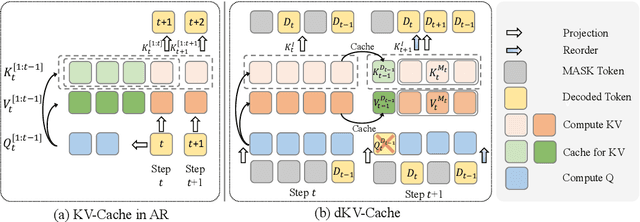
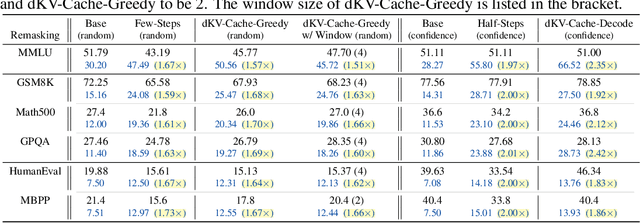

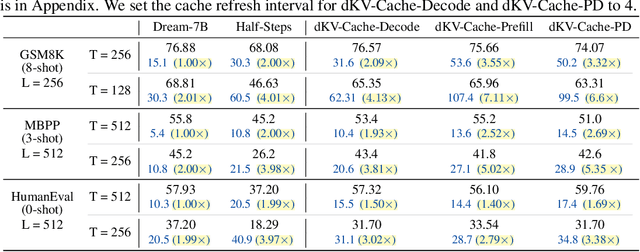
Abstract:Diffusion Language Models (DLMs) have been seen as a promising competitor for autoregressive language models. However, diffusion language models have long been constrained by slow inference. A core challenge is that their non-autoregressive architecture and bidirectional attention preclude the key-value cache that accelerates decoding. We address this bottleneck by proposing a KV-cache-like mechanism, delayed KV-Cache, for the denoising process of DLMs. Our approach is motivated by the observation that different tokens have distinct representation dynamics throughout the diffusion process. Accordingly, we propose a delayed and conditioned caching strategy for key and value states. We design two complementary variants to cache key and value step-by-step: (1) dKV-Cache-Decode, which provides almost lossless acceleration, and even improves performance on long sequences, suggesting that existing DLMs may under-utilise contextual information during inference. (2) dKV-Cache-Greedy, which has aggressive caching with reduced lifespan, achieving higher speed-ups with quadratic time complexity at the cost of some performance degradation. dKV-Cache, in final, achieves from 2-10x speedup in inference, largely narrowing the gap between ARs and DLMs. We evaluate our dKV-Cache on several benchmarks, delivering acceleration across general language understanding, mathematical, and code-generation benchmarks. Experiments demonstrate that cache can also be used in DLMs, even in a training-free manner from current DLMs.
Multi-Level Collaboration in Model Merging
Mar 03, 2025Abstract:Parameter-level model merging is an emerging paradigm in multi-task learning with significant promise. Previous research has explored its connections with prediction-level model ensembling-commonly viewed as the upper bound for merging-to reveal the potential of achieving performance consistency between the two. However, this observation relies on certain preconditions, such as being limited to two models, using ViT-based models, and all models are fine-tuned from the same pre-trained checkpoint. To further understand the intrinsic connections between model merging and model ensembling, this paper explores an interesting possibility: If these restrictions are removed, can performance consistency still be achieved between merging and ensembling? To answer this question, we first theoretically establish a performance correlation between merging and ensembling. We find that even when previous restrictions are not met, there is still a way for model merging to attain a near-identical and superior performance similar to that of ensembling. To verify whether our findings are practical, we introduce a validation framework termed Neural Ligand (NeuLig). The learning process of NeuLig is meticulously designed with a specialized loss function supported by theoretical foundations. Experimental results demonstrate the robust resilience of NeuLig in terms of both model scale and the number of collaborating models. For instance, for the case involving 5 CLIP-ViT-B/32 models, parameter-level merging achieves the same performance as prediction-level ensembling (merging: 95.44% vs. ensembling: 95.46%).
Introducing Visual Perception Token into Multimodal Large Language Model
Feb 24, 2025Abstract:To utilize visual information, Multimodal Large Language Model (MLLM) relies on the perception process of its vision encoder. The completeness and accuracy of visual perception significantly influence the precision of spatial reasoning, fine-grained understanding, and other tasks. However, MLLM still lacks the autonomous capability to control its own visual perception processes, for example, selectively reviewing specific regions of an image or focusing on information related to specific object categories. In this work, we propose the concept of Visual Perception Token, aiming to empower MLLM with a mechanism to control its visual perception processes. We design two types of Visual Perception Tokens, termed the Region Selection Token and the Vision Re-Encoding Token. MLLMs autonomously generate these tokens, just as they generate text, and use them to trigger additional visual perception actions. The Region Selection Token explicitly identifies specific regions in an image that require further perception, while the Vision Re-Encoding Token uses its hidden states as control signals to guide additional visual perception processes. Extensive experiments demonstrate the advantages of these tokens in handling spatial reasoning, improving fine-grained understanding, and other tasks. On average, the introduction of Visual Perception Tokens improves the performance of a 2B model by 23.6\%, increasing its score from 0.572 to 0.708, and even outperforms a 7B parameter model by 13.4\% (from 0.624). Please check out our repo https://github.com/yu-rp/VisualPerceptionToken
CoT-Valve: Length-Compressible Chain-of-Thought Tuning
Feb 13, 2025
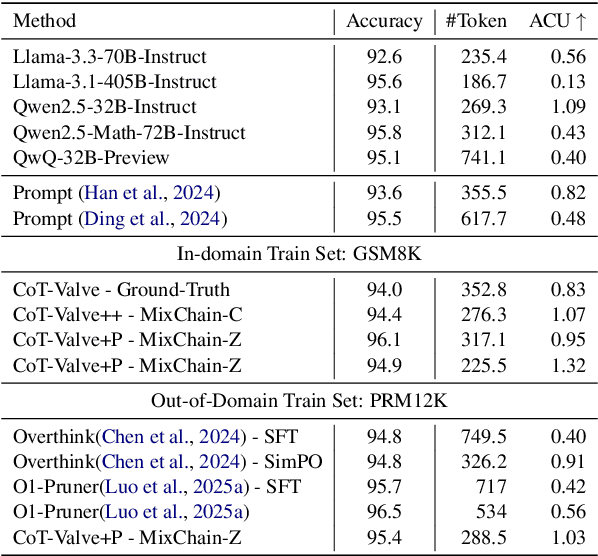
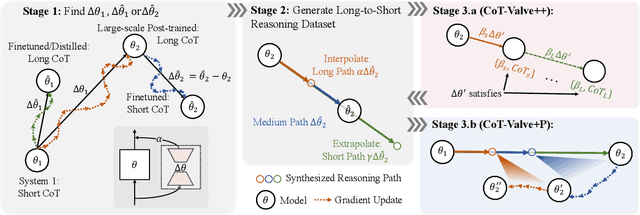
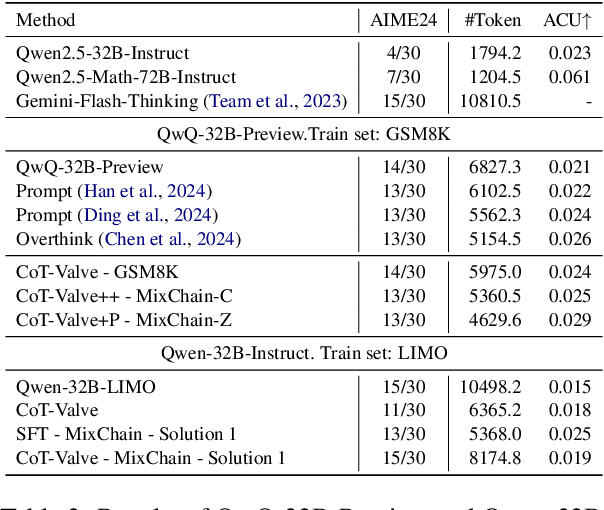
Abstract:Chain-of-Thought significantly enhances a model's reasoning capability, but it also comes with a considerable increase in inference costs due to long chains. With the observation that the reasoning path can be easily compressed under easy tasks but struggle on hard tasks, we explore the feasibility of elastically controlling the length of reasoning paths with only one model, thereby reducing the inference overhead of reasoning models dynamically based on task difficulty. We introduce a new tuning and inference strategy named CoT-Valve, designed to allow models to generate reasoning chains of varying lengths. To achieve this, we propose to identify a direction in the parameter space that, when manipulated, can effectively control the length of generated CoT. Moreover, we show that this property is valuable for compressing the reasoning chain. We construct datasets with chains from long to short for the same questions and explore two enhanced strategies for CoT-Valve: (1) a precise length-compressible CoT tuning method, and (2) a progressive chain length compression approach. Our experiments show that CoT-Valve successfully enables controllability and compressibility of the chain and shows better performance than the prompt-based control. We applied this method to QwQ-32B-Preview, reducing reasoning chains on GSM8K from 741 to 225 tokens with a minor performance drop (95.07% to 94.92%) and on AIME from 6827 to 4629 tokens, with only one additional incorrect answer.
Revisiting Self-Supervised Heterogeneous Graph Learning from Spectral Clustering Perspective
Dec 01, 2024



Abstract:Self-supervised heterogeneous graph learning (SHGL) has shown promising potential in diverse scenarios. However, while existing SHGL methods share a similar essential with clustering approaches, they encounter two significant limitations: (i) noise in graph structures is often introduced during the message-passing process to weaken node representations, and (ii) cluster-level information may be inadequately captured and leveraged, diminishing the performance in downstream tasks. In this paper, we address these limitations by theoretically revisiting SHGL from the spectral clustering perspective and introducing a novel framework enhanced by rank and dual consistency constraints. Specifically, our framework incorporates a rank-constrained spectral clustering method that refines the affinity matrix to exclude noise effectively. Additionally, we integrate node-level and cluster-level consistency constraints that concurrently capture invariant and clustering information to facilitate learning in downstream tasks. We theoretically demonstrate that the learned representations are divided into distinct partitions based on the number of classes and exhibit enhanced generalization ability across tasks. Experimental results affirm the superiority of our method, showcasing remarkable improvements in several downstream tasks compared to existing methods.
HG-Adapter: Improving Pre-Trained Heterogeneous Graph Neural Networks with Dual Adapters
Nov 02, 2024



Abstract:The "pre-train, prompt-tuning'' paradigm has demonstrated impressive performance for tuning pre-trained heterogeneous graph neural networks (HGNNs) by mitigating the gap between pre-trained models and downstream tasks. However, most prompt-tuning-based works may face at least two limitations: (i) the model may be insufficient to fit the graph structures well as they are generally ignored in the prompt-tuning stage, increasing the training error to decrease the generalization ability; and (ii) the model may suffer from the limited labeled data during the prompt-tuning stage, leading to a large generalization gap between the training error and the test error to further affect the model generalization. To alleviate the above limitations, we first derive the generalization error bound for existing prompt-tuning-based methods, and then propose a unified framework that combines two new adapters with potential labeled data extension to improve the generalization of pre-trained HGNN models. Specifically, we design dual structure-aware adapters to adaptively fit task-related homogeneous and heterogeneous structural information. We further design a label-propagated contrastive loss and two self-supervised losses to optimize dual adapters and incorporate unlabeled nodes as potential labeled data. Theoretical analysis indicates that the proposed method achieves a lower generalization error bound than existing methods, thus obtaining superior generalization ability. Comprehensive experiments demonstrate the effectiveness and generalization of the proposed method on different downstream tasks.
Attention Prompting on Image for Large Vision-Language Models
Sep 25, 2024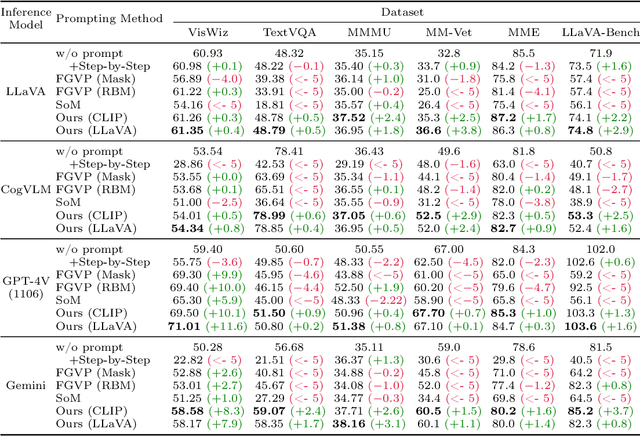
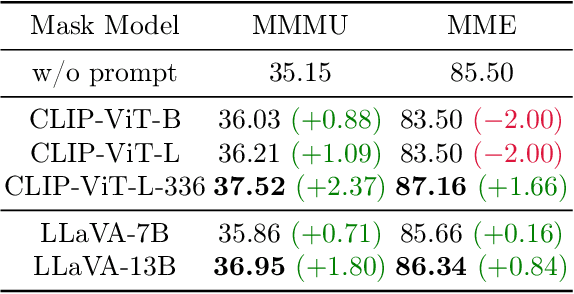
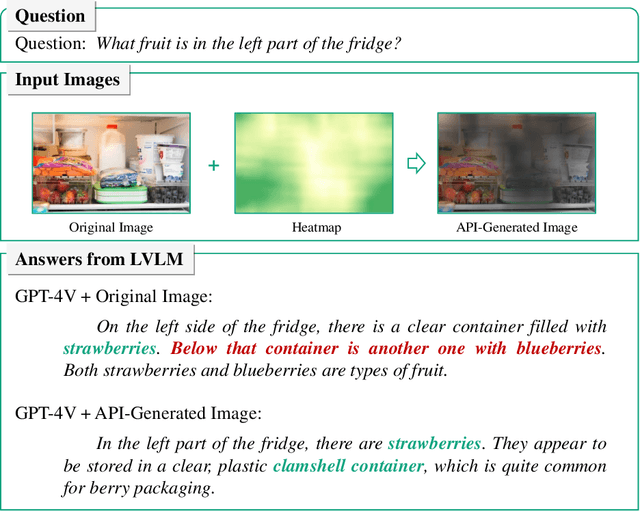
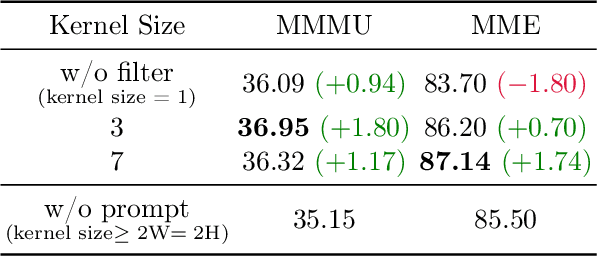
Abstract:Compared with Large Language Models (LLMs), Large Vision-Language Models (LVLMs) can also accept images as input, thus showcasing more interesting emergent capabilities and demonstrating impressive performance on various vision-language tasks. Motivated by text prompting in LLMs, visual prompting has been explored to enhance LVLMs' capabilities of perceiving visual information. However, previous visual prompting techniques solely process visual inputs without considering text queries, limiting the models' ability to follow text instructions to complete tasks. To fill this gap, in this work, we propose a new prompting technique named Attention Prompting on Image, which just simply overlays a text-query-guided attention heatmap on the original input image and effectively enhances LVLM on various tasks. Specifically, we generate an attention heatmap for the input image dependent on the text query with an auxiliary model like CLIP. Then the heatmap simply multiplies the pixel values of the original image to obtain the actual input image for the LVLM. Extensive experiments on various vison-language benchmarks verify the effectiveness of our technique. For example, Attention Prompting on Image improves LLaVA-1.5 by 3.8% and 2.9% on MM-Vet and LLaVA-Wild benchmarks, respectively.
KAN or MLP: A Fairer Comparison
Jul 23, 2024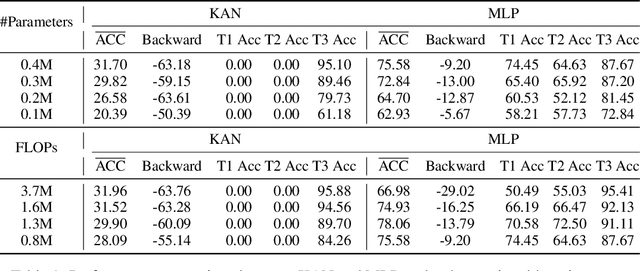
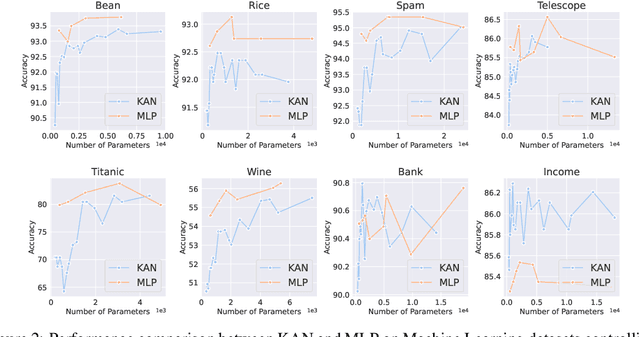
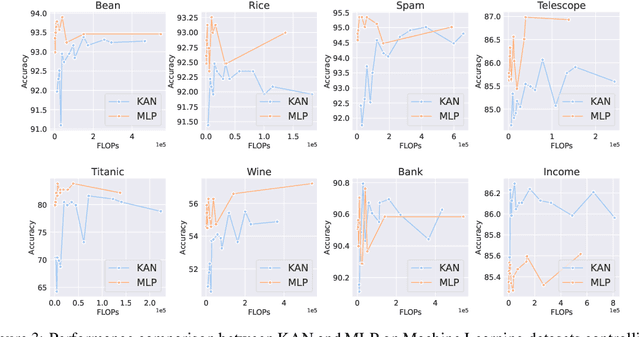
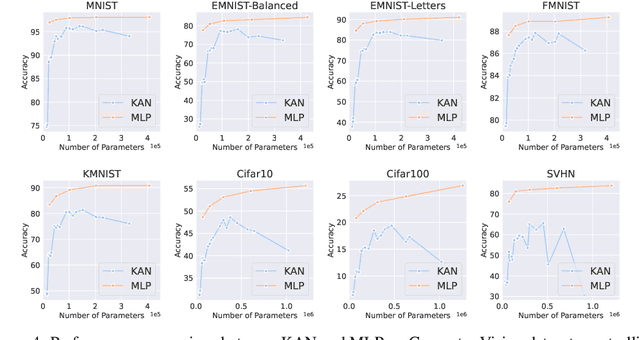
Abstract:This paper does not introduce a novel method. Instead, it offers a fairer and more comprehensive comparison of KAN and MLP models across various tasks, including machine learning, computer vision, audio processing, natural language processing, and symbolic formula representation. Specifically, we control the number of parameters and FLOPs to compare the performance of KAN and MLP. Our main observation is that, except for symbolic formula representation tasks, MLP generally outperforms KAN. We also conduct ablation studies on KAN and find that its advantage in symbolic formula representation mainly stems from its B-spline activation function. When B-spline is applied to MLP, performance in symbolic formula representation significantly improves, surpassing or matching that of KAN. However, in other tasks where MLP already excels over KAN, B-spline does not substantially enhance MLP's performance. Furthermore, we find that KAN's forgetting issue is more severe than that of MLP in a standard class-incremental continual learning setting, which differs from the findings reported in the KAN paper. We hope these results provide insights for future research on KAN and other MLP alternatives. Project link: https://github.com/yu-rp/KANbeFair
 Add to Chrome
Add to Chrome Add to Firefox
Add to Firefox Add to Edge
Add to Edge